We have come to a wonderfully subversive day of resistance; Distaff Day, of which more in a moment, but first I also want to mention that today, 7th January, is Old Christmas Day going by the older Julian calendar, which many still keep. Today is Christmas Day for those in the Eastern Orthodox and Oriental Orthodox Churches, which includes Syria, in Ethiopia, and in Eastern Europe, particularly Ukraine and Russia.
We are also marking Old Christmas Day, and Old Twelvetide, in the Little Church of Love of the World and many of us are grateful for this opportunity to weave ourselves into a quieter, more deeply-winter festive season now that the flurry of Christmas is over. For us, Christmastide will continue until Old Candlemas on 14th February. I highly recommend exploring marking festival dates by the older Julian, as well as the newer Gregorian, calendar. It is enriching, enlightening, a huge relief to have longer to journey with our holy tides, and it is a resistance to the Capitalist mindset that sweeps the holy aside in favour of returning to ‘normal’.
This winter I have been more than usually conscious of the Christmas lights on surrounding houses, and seen through cosy windows, going out one by one until by New Year there were very few remaining. That this matters is evidenced by the seemingly endless discussions on social media about when we should ‘officially’ take our decorations down; it’s as though we sense that it matters but we aren’t quite sure why. The sacred is often like that; tapping on the windows of our unconscious until we take heed.
Ultimately taking down our midwinter decorations is a choice for each of us to make, but it disturbs me when I see people proudly stating that theirs were removed as soon as Boxing Day began. What I find disquieting is the underlying suggestion that there is great virtue in removing these symbols which remind us that we are moving through a time that has meaning as soon as its possible to do so. There are still others amongst us who sadly say that they had to take down their decorations, although they hadn’t wanted to, because they were returning to work. The stranglehold of Capitalism teaches us that to comply is proof of our good character and to leave our Christmas lights up is somehow evidence of our fecklessness.
Sacred time doesn't care for clocks and no sacred day willingly allows itself to be caged by the limits of twenty four short hours; instead these times are a tide, rising in the land and her people and ebbing and flowing with the rising of the sun and the shining of the moon. And so it is with our winter festivals; of Solstice, of Yule, of Jul, of Christmas, and so many others. To reclaim kairos (sacred time) from kronos (secular time) is a gentle act of resistance that we all might embrace.
And so we come to Distaff Day.
The first Monday after Epiphany is known Plough Monday and was traditionally the day when agricultural workers, mostly male, returned to work after the Christmastide festivities. But it's less well known that there is also an equivalent day for women and women's work; Distaff, or St Distaff's, Day, which takes place each 7th January.
Spinning, the process by which raw fibre, such as wool or flax, is made into thread which later becomes cloth, traditionally requires two main tools; the distaff and the spindle. The spindle, variations of which date back to Neolithic times, is a straight spike onto which the fibre is twisted, and the distaff, also called a roc or rock, the tool used to hold the unspun fibres so that they can be teased onto the spinning spindle. To control both requires tremendous co-ordination. And this was work almost exclusively done by women.
Beautifully echoing the star of Epiphany, which we marked on 6th January, in Norse mythology the goddess, Frigg, is said to spin clouds from her sparkling distaff in a star constellation known as 'Frigg's Spinning Wheel' (also Friggerock or Orion's Belt).
Prior to the Industrial Revolution (1760-1820 approx), spinning, along with weaving and sewing, were primarily jobs of women and undertaken in the home. All three provided clothing and other essentials for their community and enabled them to care for children at the same time. By the 1300s 'distaff' had become a word for women's work, and for women's concerns in general. Chaucer was the first to record this useage in his 'Canterbury Tales', as did Shakespeare in 'King Lear'.
So intimately associated was the distaff with women's work that it had soon become a word for women themselves. By the 1500s, it had come into use to describe the women of a family; hence the phrase, the 'distaff side', meaning the female side, or the motherline. There is even a collection of French folk beliefs which relates the wisdom shared amongst late medieval women whilst spinning. Published in 1480, this collection's name translates to, 'The Distaff Gospels'.
Spinning remained deeply connected with the domestic sphere even after the Industrial Revolution, for a while at least. The early spinning machinery, such as the 40 spindle jenny, was relatively affordable for cottage workers. It was only later, when new inventions, such as the spinning jenny water frame, became too costly or too large, that spinning fell into the hands of industrialists and investors.
The majority of textile workers at this time were women, but now children, including many orphans, were also employed as their small size made them more agile in working the machinery. They would work 12 to 14 hour days, six days a week with only Sundays off, & often for poor pay. Many of the women would only take work in the factories seasonally when they could find scant work on the land. In this way relationships, with both communities and place, were slowly broken down. No wonder then, that textile workers needed a day of resistance.
Often when researching folk traditions we might find that their origins are in the 18th Century, and the move to towns and cities which threatened to break connection to the deeper tides of land and season. For example, many of our much beloved May Day traditions, such as the Jack in the Green, began in cities at that time, albeit with their roots in much older traditions.
Some might be disappointed by this, and often we tie ourselves in knots trying to prove that something is older than it is as though somehow that makes it more worthy. I celebrate it. To me, this is evidence that our impulse to belong, to build relationship with landscape & home is innate, primal. If it is suppressed or stamped out by Church or by State in one way it will only bubble up in another. You can't kill the Spirit!
We no longer remember why we considered it good to make offerings to the waters, but we continue to throw coins into wishing wells. When compelled to leave land that our families have lived on for generations to work in factories far from what and who we know, our reaction is to take the decorated milk pails carried by milk maids in May Day processions and make them more, turn them into a mass of leaves wearing a flower crown, the absolute essence of everything green and untamed. And then we dance our wild Jack around dirty streets as though we were in the familiar village where our great-great-great-grandparents fell in love and planted trees. And so we are, because this is sacred space. This is holy ground, because we make it so.
The land is not just something we live on; discrete, separate. We carry it inside us. We have hope, we carry our stories no matter what the provocation to abandon them, we transcend our circumstances, and we find meaning where meaning seems impossible. This is what it means to live in sacred time, and this is how we survive.
But St Distaff's Day, like Plough Monday, is older. Always held on 7th January, this was traditionally the day when women returned to their spinning after Midwinter. But it was also a resistance to becoming immediately subsumed in work, allowing the trickster spirit of the Christmas period to have one last outing. On Distaff Day the men, themselves not yet returned to the plough, would often try to steal, and set fire to, the women's flax and, in response, the women would attempt to soak the men from head to toe with water! And if Plough Monday and St Distaff's Day happened to fall on the same day festivities would be even more raucous.
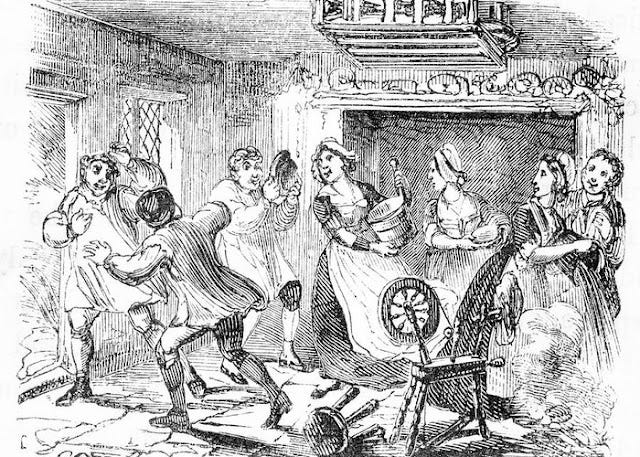
In the 17th Century, lyric poet and cleric Robert Herrick wrote of the tradition in his poem, "St Distaff's Day or the Morrow After Twelfth Night":
Partly work and partly play
You must on St. Distaff’s Day:
From the plough soon free your team;
Then come home and fother them;
If the maids a-spinning go,
Burn the flax and fire the tow.
Bring in pails of water then,
Let the maids bewash the men.
Give St. Distaff all the right;
Then bid Christmas sport good night,
And next morrow every one
To his own vocation.
And spinning truly was a vocation, not only involving skill but many hours of repetitive work; one pound of raw wool could take a week to spin, and raw cotton even longer. It was a task undertaken by women of all classes, rich and poor alike, and often in the company of other women ~ before the spinning wheel the tools and raw materials needed were easily portable and so it was possible to finish daily domestic tasks and then gather to spin in the evening, and using methods employed since the earliest times; there are images from Ancient Egypt showing women spinning in exactly this way with a distaff and spindle.
We are entering again the female space of winter. Here we find Catterntide, a celebration for lacemakers, on November 25th as we began our journey, the Anglo-Saxon 'Mõdraniht', or 'Mothers' Night', on Christmas Eve, Mary birthing the Christ child, the Mari Lwyd; the 'Grey Mare' of South Wales, at Midwinter, Women's, or Little, Christmas on 6th January, and Distaff Day & the work of spinning on 7th January as we emerge (we might also trace 'male space', from Martinmas to Plough Monday).
St. Distaff Day was also a time to honor 'mother’s spit'. Mother’s spit was an important ingredient in flax production, wetting flax fibres with saliva, which contains an enzyme that decomposes the cellulose of the flax into a sticky substance & so helps splice the threads together into yarn.
Records of St Distaff Day begin in the 14th Century, or the Late Middle Ages. It was during the Later Middle Ages that the woollen industry became the major source of income for many, with huge swathes of land dedicated to sheep farming. This was also the time when spinning moved from the domestic sphere; making yarn for use by family and close community, into being a marketable commodity.
But these were the years of the Great Famine of 1315 to 1317, the Black Death, which reached England in 1348, the Hundred Years' War with France; events which killed almost half of England's population and caused economic chaos and the unravelling of the old social order. No wonder that both women and men felt the need to 'draw the line'.
During this time nearly 1,500 villages were deserted and men and women were forced to look for work in towns and cities. Accompanying social unrest brought events such as the Peasants' Revolt of 1381. As an aside, Mr Radical Honey occasionally buys his fine English fellow's apparel in Canterbury from a the great-great-great-etc-etc-grandson of Wat Tyler, and although he works in a very traditional gentlemen's outfitters he definitely has something of the rebel about him!
In the midst of this social upheaval came St Distaff's Day; an acknowledgement that women's work must be done, but also a reminder that we are more than the work we do, more than our usefulness to the economy. There are relationships to be maintained, lines to be drawn between workers and those who benefit financially from that work, lines that everyone is supposed to know about. That the day was dedicated to a saint of course added credence to the determination not to work, or not too hard at least. Saints’ Days were for feasting, or for its sister fasting, but folk saints' days always fall on the feasting (and drinking) side!
But there is no 'Saint Distaff'. This is yet another example of an 'unofficial saint's holiday' designed to increase the potential for merrymaking. And Merrymaking is Resistance. All the same I think that we might confer sainthood on a tool which has so benefitted us for millennia; especially one that holds a chaotic tangle of raw material and allows us to make sense of it; a saint to help us with that work would be welcome indeed.
Observance of St Distaff's Day continued for almost five centuries until the Industrial Revolution took the task of spinning into factories, dividing the women from the men, and moving work from the domestic cottage industries where one could manage one's own time into a sphere and time which was no longer one's own. When work is done by the clock there is no space for a day of merrymaking to get used to the idea of Christmas ending. And we might hazard a guess that the loss of the full Twelve Days of Christmas festivities, symbolised by our traditional 'Twelfth Cake' becoming instead a cake for Christmas day, meant that women would have returned to work well before St Distaff's Day.
You can watch a delightful video about the history and making of Twelfth Cake below. As a slight aside, I highly recommend following Townsends, who have provided me with my new favourite New Year saying; “New Year. New nutmeg.”
We might celebrate then that Distaff Day is returning as more of us become interested in our old festivals and celebrations; some without quite knowing why, some to honour where we've come from, some as an act of conscious Resistance to the strangle hold of secular time and space.
St Distaff's Day is the perfect time to gather with others for a post-Christmastide creative afternoon but also, in this time when we are so divided from those who provide us with our material comforts, to consider the lives of the people who make our clothes, often under exploitative and unsafe conditions and with low wages in countries where rules protecting workers are non-existent. We might reflect upon who is doing the 'spinning' now, and are WE the ones who the Resistance must be against? I pray to St Distaff to help us all make choices grounded in justice, dignity, and right relationship in the year ahead.
We will reclaim this world; not through force but by making holy; one thread, one stitch, one seed, at a time.
And here, it comes to me, is the perfect tune to accompany us on these 'Wild Saint Days of Resistance'!
Go on and speak your mind,
lets find out what it is you have to say
I hope nobody turns away
You said it loud and clear;
We have to work,
we have to earn our way
well I'm sorry not today
Oh I'm sorry not today
Truth is if I dont make it,
then you cant take it
and if I dont sew it
then you cant wear it
truth is if I dont grow it,
then you can eat it
And if I dont aim it,
then you cant shoot it
It's that little bit left over at the end...
(The Levellers)
Free Palestine.
#Christmastide #Twelvetide #Midwinter #DistaffDay
I am determined to continue offering my work free of charge, because that too is resistance, but if you would ever like to support me with pennies you can do that at https://ko-fi.com/radicalhoneybee. Thank you so much, both for pennies and for all other forms of support, all of which are worth more than their weight in gold.
References:
St Distaff's Day ~
https://www.ingebretsens.com/blog/on-the-close-of-st-distaff-day/
https://www.tudorsociety.com/happy-st-distaffs-day/
http://www.thebookofdays.com/months/jan/7.htm
http://www.tellinghistory.co.uk/resources/distaff.htm
https://norfolktalesmyths.com/2019/01/02/who-believes-in-st-distaff/
Spinning ~
https://en.m.wikipedia.org/wiki/Spinning_(textiles)
http://spinning-wheel.org/about1/
On 15th Century spinning techniques ~
https://15thcenturyspinning.wordpress.com/2012/06/16/how-did-women-spin-in-the-15th-century/
http://medievaleuropeilluminated.blogspot.com/2017/10/spinning-through-time-distaff-and.html?m=1
The Distaff ~
https://en.m.wikipedia.org/wiki/Distaff
https://www.merriam-webster.com/words-at-play/distaff-meaning
Distaff Day: Fun and Fire?, Jillian Eve
The Spindle ~
https://en.m.wikipedia.org/wiki/Spindle_(textiles)
The Middle Ages ~
https://en.m.wikipedia.org/wiki/Late_Middle_Ages
https://en.m.wikipedia.org/wiki/England_in_the_Middle_Ages
https://en.m.wikipedia.org/wiki/England_in_the_Late_Middle_Ages
The Industrial Revolution ~
https://en.m.wikipedia.org/wiki/Industrial_Revolution
https://en.m.wikipedia.org/wiki/Textile_manufacture_during_the_British_Industrial_Revolution
Women's Christmas ~
https://en.m.wikipedia.org/wiki/Little_Christmas
https://www.irishcentral.com/roots/womens-christmas-nollaig-na-mban-celebrate-ireland
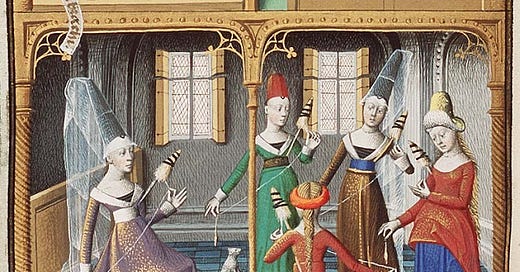





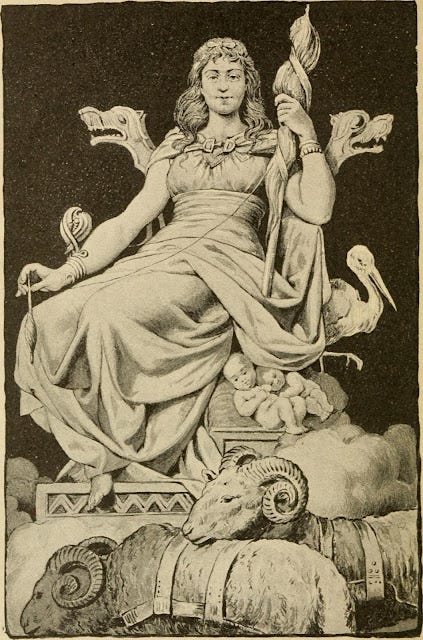

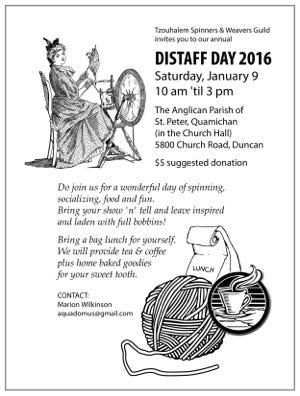
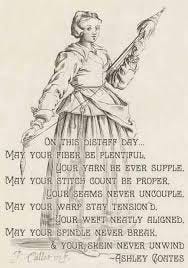
I knew NONE of this, absolutely fascinating, thank you so much 🙏🏼
I've done a bit of spinning -- wool & linen mostly -- & I will tell you that if some guy comes along & burns the linen I'm working on I'm gonna hit him with something a lot harder than a bucket of water! He can have the leftover short tangled bits, & while he's at it, he can use that to help get the fire going.